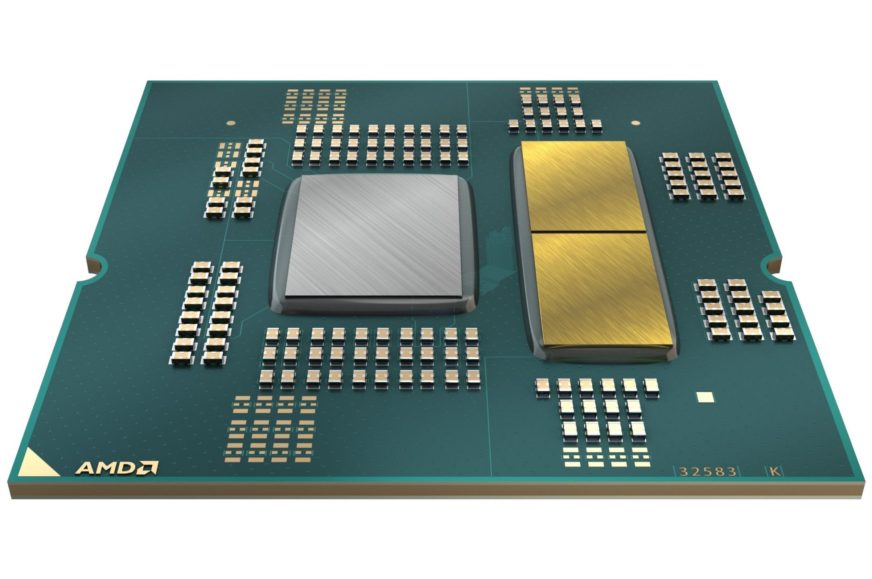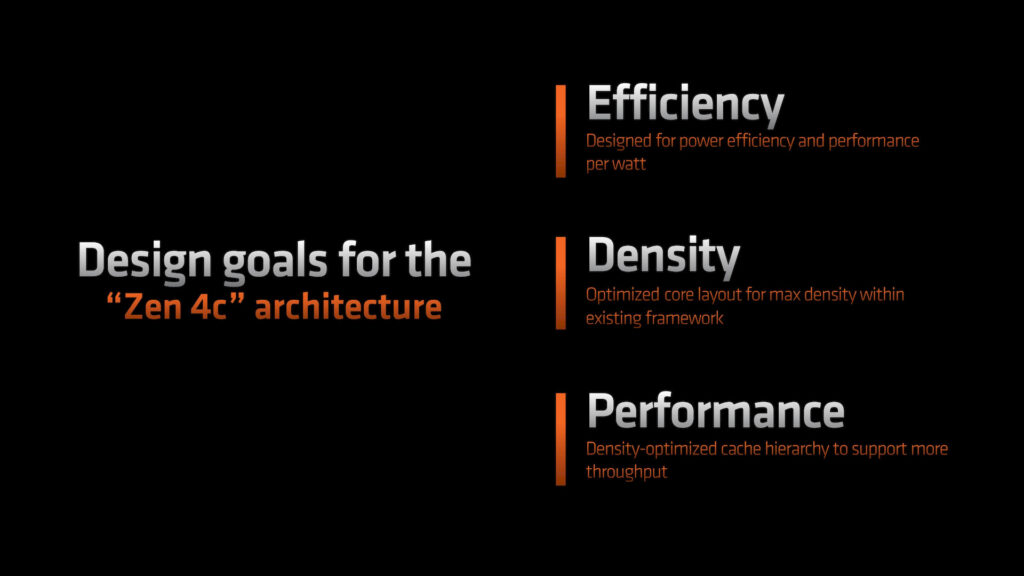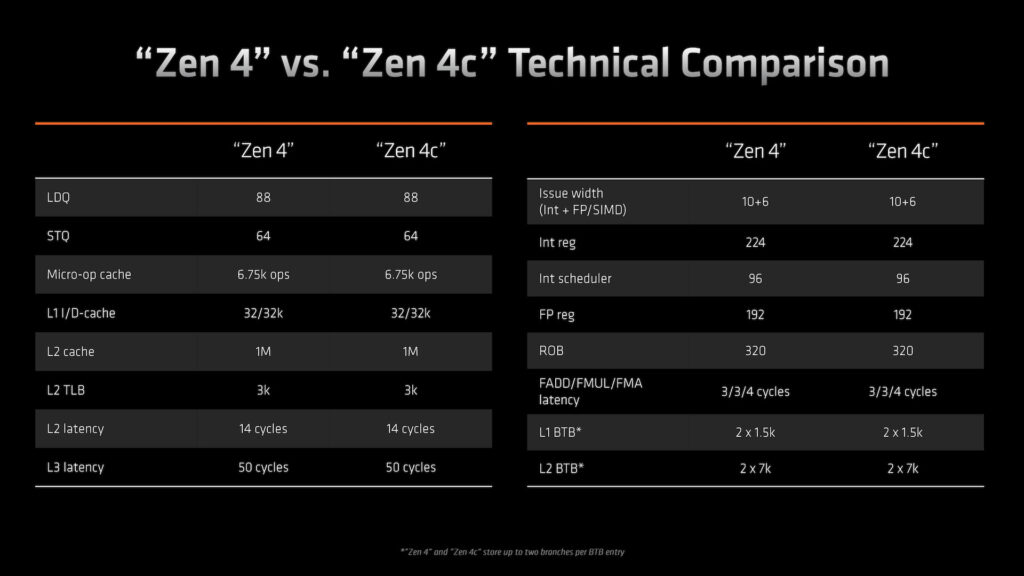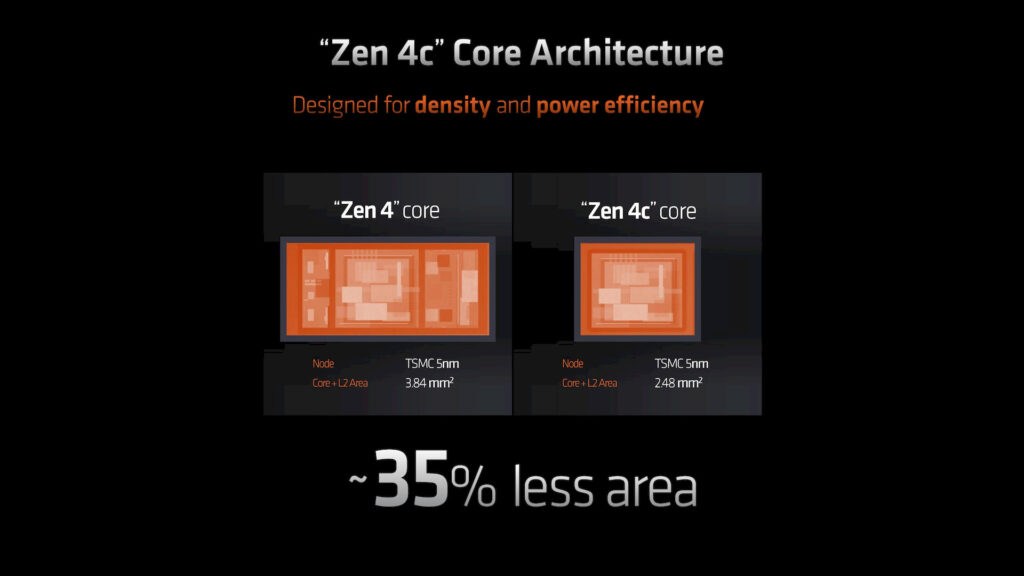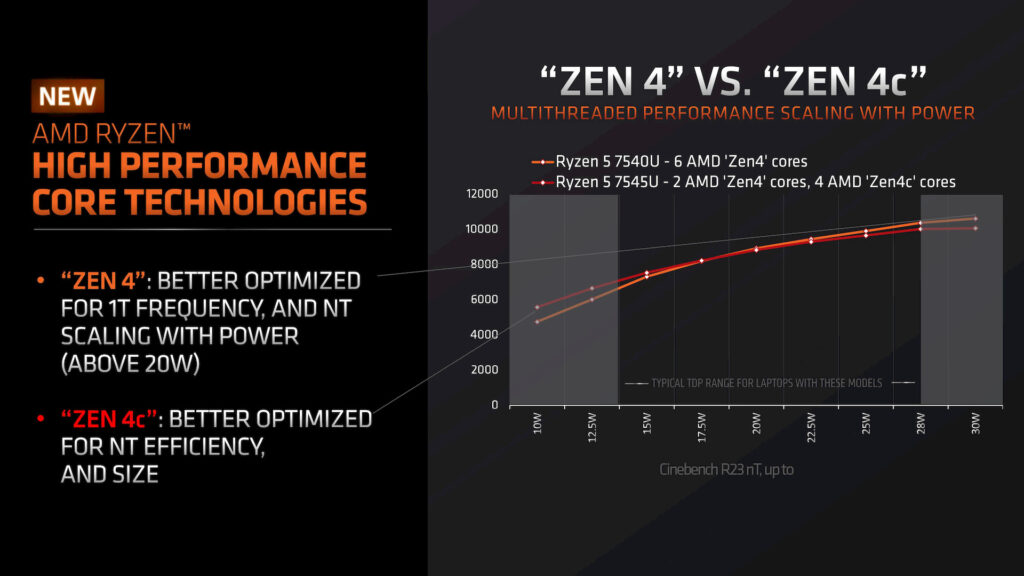Ryzen 5 7545U and Ryzen 3 7440U: First APUs officially using Zen 4c
In the summer, we reported that AMD started using Zen 4c cores in its Ryzen 7000 laptop processors. AMD appeared to use a new die with small (or compact) Zen 4c cores known as Phoenix 2 or unofficially Little Phoenix to make four and six-core models, alongside the standard versions based on a stripped-down Phoenix chip containing eight big Zen 4 cores. But the release of these APUs has been officially announced by AMD only now.
Yesterday, AMD officially released or announced two new models of Ryzen 7000 “U” series, i.e. processors designed for mainstream laptops with TDP of 28 W, adjustable between 15 and 30 W. The original 7040U series based on the Phoenix die with eight Zen 4 cores was announced back in May, but now AMD is adding two more models. And these are special because they are the first to openly use the “big.LITTLE” core composition and the 137 mm² Phoenix 2 chip.
The two new models are the Ryzen 5 7545U and the Ryzen 3 7440U. If you follow us regularly, you probably know that we already covered the use of the Phoenix 2 in the 7540U and 7440U – but it was an unofficial thing at that time, back then the use of these smaller dies was observed or discovered from other sources. And AMD seems to have used multiple configurations, so at the very least the Ryzen 5 7540U could probably exist in both a hybrid version and with Zen 4 cores alone (both versions should probably behave similarly though).
Zen 4c openly
Now AMD has announced that the 7540U and the original 7440U are being replaced by the Ryzen 5 7545U and Ryzen 3 7440U (which has not been renamed) in the lineup. These differ in that they are now made solely from the Phoenix 2 dies, and will therefore always have a hybrid mix of Zen 4 and Zen 4c cores.
The Ryzen 5 7545U has the same specifications as the 7540U – six cores, 12 threads with 16MB L3 cache (the Phoenix 2 chip retains the same L3 capacity as the full-fat Phoenix), a base clock speed of 3.2 GHz and a maximum boost of 4.9 GHz. The latter will apply to Zen 4 cores, not Zen 4c. Compared to the previous model, it is now clearly stated that two Zen 4 cores and four Zen 4c cores are used.
Both processors have integrated Radeon RX 740M GPUs. This configuration means the use of four RDNA 3 architecture CUs, or 256 shaders and 4 ray accelerators. The GPU clock speed is up to 2800 MHz for this model.
The new Ryzen 3 7440U has unchanged specifications compared to the previous version with this designation. But now it will also be explicitly based on the big.LITTLE Phoenix 2 chip. Its clock speed is 3.0 GHz base and 4.7 GHz in the maximum boost on the Zen 4 core. It’s cut down to four cores and eight threads, and it’s explicitly stated that there’s just a single big Zen 4 core and three Zen 4c cores. Also, the L3 cache is cut down to 8 MB.
The GPU is also the Radeon RX 740M with 256 shaders, but with this model it has a lower clock speed. The GPU on both supports resolutions up to 7680×4320 pixels at 60Hz, HDMI 2.1 and DisplayPort 2.1 with UHBR10 speed. The ability to encode up to 8K video to AV1 format also remains, but on the other hand the processors don’t have the Ryzen AI accelerator.

Both processors otherwise support DDR5-5600 and LPDDR5X-7500 memory and should natively support USB4 at 40Gb/s (and USB 3.2 Gen 2 at 10Gb/s). AMD states that they include a PCIe Express 4.0 controller providing 14 lanes.
Version for AM5?
It is now being discussed that AMD could release the Phoenix 2 die in AM5 format for desktop boards but that leaves questions about the feasibility. AMD has confirmed that Phoenix 2 has a dual-channel memory controller, but if 14 PCIe lanes is the maximum and there is no controller on the silicon for more, then after using four lanes to connect to the chipset there would only be a ×4 interface left for the discrete graphics card PCIe slot (the main slot with ×16 physical length) and the two CPU interfaces dedicated to NVMe SSDs would have to make do with ×4 and ×2 lanes. Alternatively, perhaps it could be ×8 for the GPU, ×2/×2 for the SSD, and a ×2 for the chipset, but we don’t know if it’s possible to reduce the number of lanes for the connection to the chipset.
Small cores not only save manufacturing costs, they can also improve performance
As with the server processors with Zen 4c architecture, these cores have exactly the same IPC – all architectural characteristics, supported instructions and features (SMT) are preserved.
The only difference is that the core achieves lower clock speeds due to the use of libraries and optimizations aimed at higher density instead of higher performance – in return, it takes up 35% less space. The die area is 2.48 mm² versus 3.84 mm² for the classic Zen 4. This also includes the L2 cache, which hasn’t shrunk with Zen 4c, so the “shrinking” of the core logic outside of L2 is even more pronounced.
According to AMD, the difference is not only in the size of the core on the chip. The Zen 4c optimizations also give this core a slight boost in power efficiency compared to the big Zen 4 in a part of the clock speed curve. This should mean that at lower clock speeds the power draw is slightly better than the equally clocked and thus equally fast big Zen 4. At higher clock speeds, the difference is erased and the curves intersect. After that, the Zen 4c starts to run out of breath, and as it approaches its peak, its efficiency drops and it becomes less advantageous at higher clock speeds. It is not capable of the absolute highest clock speeds that Zen 4 allows at all.
This characteristic makes it clear how Zen 4c can be useful in a mobile processor. Phoenix 2 contains two Zen 4 cores, which it uses for single-threaded and low thread-count applications. These cores are presented as preferred by the processor and the Windows operating system will automatically use them first, so it should not happen that a single-threaded application will be slowed down by Zen 4c. No additional special software support should be needed to operate them in contrast to Intel’s big.LITTLE processors.
However, if a multithreaded application using all cores is running, the small Zen 4c cores, of which the Phoenix 2 chip has four, get to be put to use. When used in a processor with a TDP of 15–28 W, each core has to reduce its clock speed to allow all-core load within a given power draw envelope, and it is likely that the resulting clock speed will already be in the range that the Zen 4c cores can handle – either with only a small efficiency penalty, or with the same or better power efficiency. If the CPU cores are already running at a level where Zen 4c’s efficiency is better, the CPU will be able to set a slightly better clock speed, and performance will therefore improve against the alternative with all large cores.
The lower the power draw that the laptop maintains under load, the more the Zen 4c will have an advantage. AMD has an example in the slides with the Cinebench R23 benchmark that says the Zen 4c should have an advantage at 15W power draw, roughly parity somewhere around 17.5W, and above 20W it could probably be at a slight disadvantage.
The BGA package of these processors should be compatible, so they can be rolled into already existing notebook models, including ones already on sale, virtually unannounced. New laptop products based on these APUs will probably be rolled into the market without any big announcements, given that these are rather cheaper products, so expect them to mostly just start appearing on shelves and in shop listings.
Sources: AnandTech, TechPowerUp
English translation and edit by Jozef Dudáš
⠀





